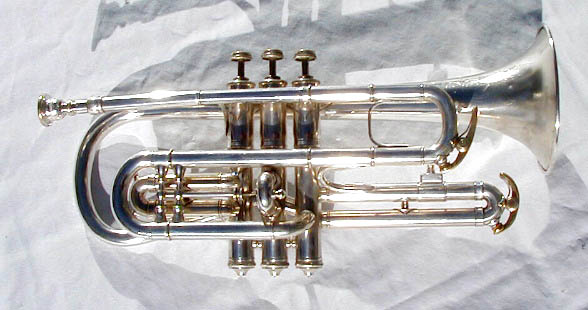Conn Perfected Wonder with mechanism

Date: 1908. Image Courtesy Silver Horns
When Conn was still owned by Col. Conn himself models cornet that resembled each either very closely: the Perfected Wonder, and the New Invention Circus Bore. For a long time I thought these were the same model. However, the cornet expert and collector H.M. Lewis has explained to me how to tell the difference.
The Perfected Wonder model was built between approximately 1906 en 1910. The "Wonder" models, which include the Wonder, New York Wonder, Wonderphone, Perfected Wonderphone and the Perfected Wonder have in them patent number 343888, which is a patent for valve design. The easiest way to see this is to look at the short tube that connects the 3rd valve to the 2nd valve: in these models, following the patent, this tube is angled up from the 3rd valve to the 2nd valve. On the New Invention Circus Bore, this tube is horizontal. In 1911 the Conn factory was destroyed by fire. It is reasonable to assume that the change from Perfected Wonder to the Circus Bore model occurred after that fire.
I am told by H.M. Lewis that all the Perfected Wonders he has played had "fairly severe intonation problems." The Perfected Wonder was made, at least, in "SS", "S" and "M" bores (approximately 0.404", 0.415" and 0.445", respectively).
A patent for an instrument that matches the Perfected Wonder with mechanism exactly was applied for by C.G. Conn (himself, believing the patent application) on January 8, 1906, patent number 828,273. The patent reads, in part: "This invention relates to improvements in cornets, and has for its principal object to provide a key-changing slide which when moved to change the pitch of the cornet will at the same time operate a suitable mechanism to extend the valve-slides sufficiently to make them correspond to the lowered pitch of the instrument." The patent applications continues: "A further object of the invention is to provide a mechanism which will enable the cornetist at a single movement to instantaneously change the pitch of the instrument and at the same time and by the same movement adjust all the valve slides."